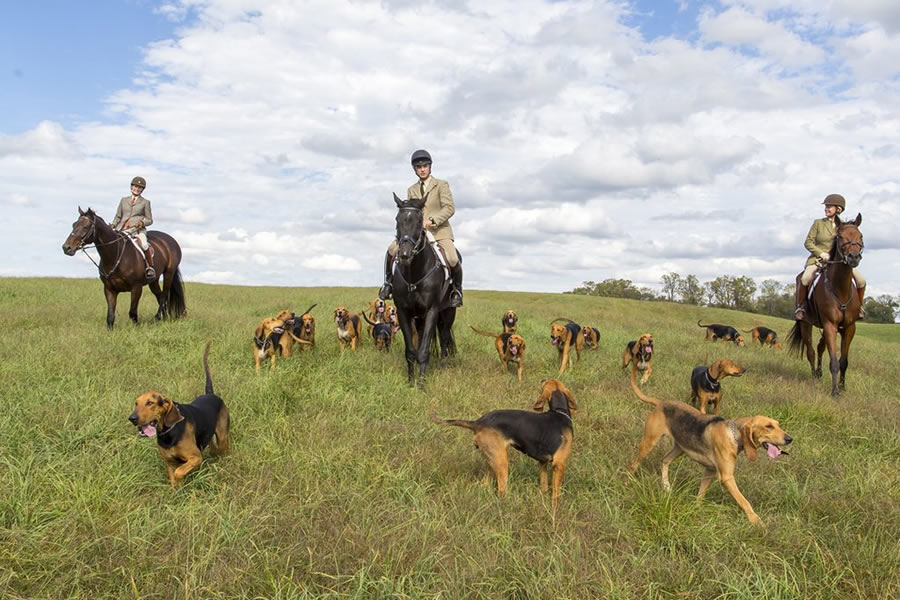
Cub hunting and How To Sab Them
The object of cub hunting is :
a) to train young foxhounds in pack work, to follow the older hounds, obey the horn and calls of the huntsman, to familiarise themselves with the scent of the fox so they don't riot after other animals and to give them the taste of fox blood.
b) to disperse the fox cubs over a wider area (especially from coverts that can't be visited in the main season due to their position near roads, railways and other hazardous places) so there will be foxes in most coverts to provide better sport, to persuade cubs that safety lies not in going to ground but in fleeing across country - thus providing good runs.
c) to reduce fox numbers.
Cub hunting takes place in the early morning when scent is at it's best, before the heat has dried it up. But sometimes the more popular evening meets are held, taking place as the sun begins to lose its strength at the end of the day.
As with the fox hunt the huntsman, hounds and whippers-in are present, but the followers are normally reduced and are invited by the Master to attend. Hounds will go straight from the kennels to the covert and the field will usually wear ordinary hacking gear.
Late July, August and September
On arrival, followers will be positioned round the perimeter in order to keep the cubs (and hounds) in the wood, this is called 'holding-up'. If a cub is seen exiting it will be frightened back by the mounted followers slapping their saddles with their crops. The idea is to keep both cubs and hounds in the close confines of the wood so that the young hounds will learn to hunt in thick covert where they have to use their noses, and listen and follow the cries of the old hounds. It is not unusual for cubs to be dug out and given to the hounds, thus giving them a taste of fox blood.
October
Runs in the open will be encouraged so that young hounds can learn to hunt on the right line, to see the fox and know what it looks like, therefore earths may be blocked up. It is also time to disperse the cubs. The cubs will be between four and seven months old, having been born between the end of January and the beginning of May. By the time fox hunting starts, they will be almost fully grown and also by this time they will know that the sound of the horn is the signal to leave the covert and run.
Sabbing a Cub Hunt
Most hunts know exactly which woods harbour litters of fox-cubs. Coverts are owned by hunt supporters and are often carefully protected by their owners so that by the time the cub-hunting season starts the hunt has all the information it needs to decide which woods to hunt and of course plenty of young foxes to kill. Since foxes tend to bred in the same coverts from generation to generation you should keep records of which woods are hunted during cubbing and use this information to your advantage in future years. Pre-meet work is vital during cub-hunting.
The most effective means of sabbing a cub hunt is by using pre-spraying methods before the hunt meets - refer to tactics already mentioned for pre-meeting fox hunts. Sabs should bear in mind two problems at this time of year, a) the density of the coverts and b) the time in the morning that cubbing takes place. For pre-beating, rookies can be especially useful as they remain effective during the course of the hunt.
In early season cubbing it is important to try horn blowing and calling to confuse the new and inexperienced hounds, try to compete with the huntsman for control (a pack which riots easily will be difficult for the huntsman to control in the coming season). If the hunt enter a covert that has not been pre-sprayed, it is essential to call them out by horn or voice from different directions.
False trails can also be used and they should be laid so that the false trail comes straight out of the wood. If a few hounds appear to be interested in it they should be encouraged by the sabs to hunt the trail, (doubling the horn is the best tactic to do this). This tactic (trail laying) should be done early in the season when the coverts are being held up and the huntsman is more interesting in teaching his young hounds to kill rather than to hunt a foxes line. Later in the season when the hounds are being trained to hunt a line sabs should stop the chases at the first opportunity.
For late Autumn cubbing adopt tactics as for fox hunting.
It should be noted that there is reduced advertising of meets during the cubbing season, as its function is not necessarily to provide 'sport' for subscribers in the short term. The long term functions are :
1) to spread cubs over a wide area during the late autumn cubbing so that there is less chance of blank day,
2) to encourage cubs to run from the coverts rather than go to earth and
3) to teach young hounds to kill.
Some hunts conduct cub hunting in early evening and all hunts when cubbing will hunt more often during the week, anything from three to six days. Sabs waiting in a prominent position outside the kennels have been known to dissuade some hunts from cubbing.

